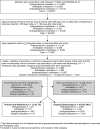Characteristics of patients with primary non-adherence to medications for hypertension, diabetes, and lipid disorders
- PMID: 21879374
- PMCID: PMC3250550
- DOI: 10.1007/s11606-011-1829-z
Characteristics of patients with primary non-adherence to medications for hypertension, diabetes, and lipid disorders
Abstract
Background: Information comparing characteristics of patients who do and do not pick up their prescriptions is sparse, in part because adherence measured using pharmacy claims databases does not include information on patients who never pick up their first prescription, that is, patients with primary non-adherence. Electronic health record medication order entry enhances the potential to identify patients with primary non-adherence, and in organizations with medication order entry and pharmacy information systems, orders can be linked to dispensings to identify primarily non-adherent patients.
Objective: This study aims to use database information from an integrated system to compare patient, prescriber, and payment characteristics of patients with primary non-adherence and patients with ongoing dispensings of newly initiated medications for hypertension, diabetes, and/or hyperlipidemia.
Design: This is a retrospective observational cohort study. PARTICIPANTS (OR PATIENTS OR SUBJECTS): Participants of this study include patients with a newly initiated order for an antihypertensive, antidiabetic, and/or antihyperlipidemic within an 18-month period.
Main measures: Proportion of patients with primary non-adherence overall and by therapeutic class subgroup. Multivariable logistic regression modeling was used to investigate characteristics associated with primary non-adherence relative to ongoing dispensings.
Key results: The proportion of primarily non-adherent patients varied by therapeutic class, including 7% of patients ordered an antihypertensive, 11% ordered an antidiabetic, 13% ordered an antihyperlipidemic, and 5% ordered medications from more than one of these therapeutic classes within the study period. Characteristics of patients with primary non-adherence varied across therapeutic classes, but these characteristics had poor ability to explain or predict primary non-adherence (models c-statistics = 0.61-0.63).
Conclusions: Primary non-adherence varies by therapeutic class. Healthcare delivery systems should pursue linking medication orders with dispensings to identify primarily non-adherent patients. We encourage conduct of research to determine interventions successful at decreasing primary non-adherence, as characteristics available from databases provide little assistance in predicting primary non-adherence.
Figures
References
-
- Sokol MC, McGuigan KA, Verbrugge RR, Epstein RS. Impact of medication adherence on hospitalization risk and healthcare cost. Med Care. 2005;43:521–530. doi: 10.1097/01.mlr.0000163641.86870.af. - DOI - PubMed
Publication types
MeSH terms
Substances
Grants and funding
LinkOut - more resources
Full Text Sources
Medical


